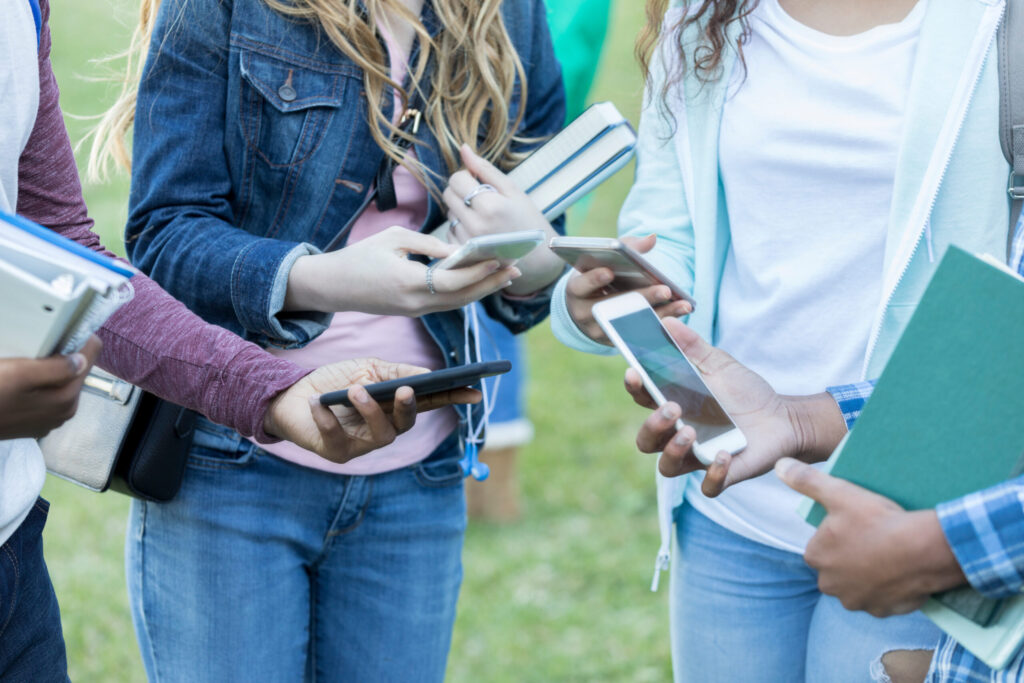
A group of teenagers checking their cellphones. (Courtesy of SDI Productions via Getty Images)
Gov. Glenn Youngkin announced Executive Order 43 on Thursday, which enacted a multi-pronged effort to address the impact of social media use on children’s mental health. The order established the Reclaiming Childhood Task Force to counter “addictive” social media use in youth and “create opportunities for cultural change.”
The directive came months after the governor issued an executive order requiring the Department of Education to draft guidelines for cell phone-free schools.
The latest order will mobilize state agencies to provide resources for parents, educators and healthcare providers to “combat the negative effects of excessive social media use.” It will also spur the agencies to create a toolkit with training materials and educational resources that will “offer educational and technical support” for health care providers and families to promote healthy social media use.
“The scope of this challenge is going to require all of us, private sector, non-profit organizations and (the) government to support parents as they work to improve their children’s mental health,” Youngkin said in a release.
The task force will convene parents, youth, teachers, mental health experts, faith leaders, public safety officials and private sector technology experts to compile recommendations to share with Youngkin and members of the General Assembly.
Secretary of Health and Human Resources Janet Kelly noted the “addictive” nature of social media algorithms. The order cites Pew Research Center data showing 95% of U.S. teens use social media, and Gallup studies showing that youth use social media frequently and that 41% of high-frequency social media users report having “poor or very poor mental health,” with the percentage higher for teens who use it with low parental monitoring.
“The Reclaiming Childhood Task Force will drive collaboration and innovation to address this mental health crisis and ensure our children grow up with the tools they need to thrive,” Kelly wrote.
When the cell phone-free guidelines for schools were being developed this past summer, academics noted the adjustment period they would require for students who have grown accustomed to frequent cell phone and social media use.
David Naff, a Virginia Commonwealth University professor with a concentration in educational psychology, said in an interview at the time that he hoped the policy would help youth become more intentional about when they use their devices outside of school hours.
It’s human nature to crave social interaction, Naff said, “whether we realize it or not” and social media interactions are less personal than face-to-face interactions. He also noted how research points to increased device use and social media access contributes to anxiety and other mental health issues in today’s younger generations — research also cited in Yougnkin’s order.
Naff also noted still-emerging research on the effect the COVID-19 pandemic had on kids.
When the virus first plagued the globe roughly four years ago and triggered shutdowns of public life, education pivoted to virtual learning for a time. This meant youth were on screens more than ever before while missing out on the personal interactions of in-person learning.
“It’s kind of hard to distinguish the COVID mental health impacts from the cell phone use mental health impacts, because they’re overlapping. When schools were closed, our world just moved online,” Naff said. “So then, adolescents are using devices and social media more frequently at that point. Someone could argue that the mental health impacts were related to COVID — which they were — but you could also say ‘maybe at least a portion of the mental health impacts were that we’re just on our devices constantly, like to the point of addiction.’”
GET THE MORNING HEADLINES.

